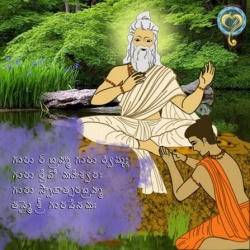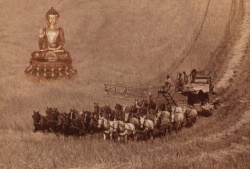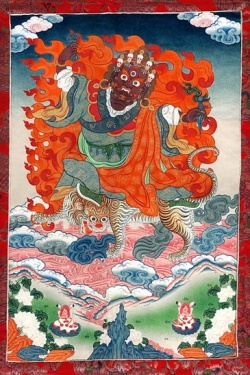Samsara and Tao: Crossing the river to the other shore while going with the flow
Tetsunori Koizumi, Director
If Hinduism and Buddhism represent two major systems of thought that came out of India, Taoism and Confucianism two major systems of thought that came out of China. While Buddhism and Confucianism had definite historical figures as their founders whose lives are well recorded, Hinduism had no such figure that could be called the founder, and it has taken a long time before it has become a system of thought called Hinduism that we know today. What about Taoism, then? Was not Lao Tzu its founder?
Actually, not much is known about the historical Lao Tzu. Since so little is known about him, some scholars doubt that Lao Tzu existed as a historical figure. According to The Book of History written by the Han historian Sima Qian, Confucius is said to have paid a visit to Lao Tzu when the latter was working as a librarian in the Zhou Empire but was summarily sent back by Lao Tzu for being hypocritical when he sought Lao Tzu’s opinion on li. Nevertheless, Confucius is said to have been impressed with Lao Tzu. As the Zhou Empire declined, Lao Tzu decided to live the life of a recluse. As he was ready to leave the city-gate, the gatekeeper, recognizing him and well aware of his reputation as a wise man, asked Lao Tzu to write down his ideas. The work, which Lao Tzu left with the gatekeeper before disappearing from the Empire, was said to be Tao Te Ching.
Most scholars doubt that the meeting between Confucius and Lao Tzu actually took place. They come to this conclusion because it is clear from the passages in Tao Te Ching that the author was (or the authors were, in case Tao Te Ching was written by many authors) conscious of Confucius’ work and tried to develop a naturalistic philosophy in sharp contrast to Confucius’ interventionist philosophy, especially as regards one’s conduct in social life.
Lao Tzu is best known for his concept of Tao, which he introduces as the term to describe the cosmic principle that prevails in the universe: “Something mysteriously formed, Born before heaven and earth. In the silence and the void, Standing alone and in motion. Perhaps it is the mother of ten thousand things. I do not know its name. Call it Tao.”1
As we can surmise from these lines, Tao is not the name for some substance but rather refers to the process by which the universe comes into being and evolves. That Tao is the evolutionary principle that prevails in the universe is made more explicit by the following lines: “The Tao begot one. One begot two. Two begot three. And three begot the ten thousand things. The ten thousand things carry yin and embrace yang. They achieve harmony by combining these forces.”2
Lao Tzu brings in here the idea of yin-yang duality as the complementary forces behind cosmic evolution. Moreover, if cosmic evolution is ruled by the yin-yang duality that achieves harmony, it follows that we would be best off by lettings things evolve according to their natural tendency. Thus, Lao Tzu’s philosophy of wu wei, which is usually translated as “non-action”, is derived as the natural consequence of his view of the world represented by his idea of Tao: “The world is ruled by letting things take their course. It cannot be ruled by interfering.”3
By following the Tao, by “non-action”, we can actually accomplish a great deal, just like water does in the universe: “The highest good is like water. Water gives life to the ten thousand things and does not strive. It flows in places men reject and so is like the Tao.”4
“Non-action” as a way of life, needless to say, is a radical idea. But what does “non-action” really mean? Of course, it does not literally mean “non-action” in the sense of “doing nothing”. Indeed, wu wei is Lao Tzu’s prescription for the “right action” that requires us to take action in harmony with the ongoing cosmic process. This is what Lao Tzu means when he says, “Tao abides in non-action, yet nothing is left undone”5.
How does wu wei compare with the Noble Eightfold Path, which is quite specific as to what we need to do to accomplish liberation and enlightenment? To answer this question, we must first find a concept in Buddhism, which is equivalent to Tao. What comes closest to Tao in Buddhism would be samsara, which is usually translated as “wandering on”. For example, this is how the Buddha talks about samsara: “Monks, this samsara is without discoverable beginning. A first point is not discerned of beings roaming and wandering on hindered by ignorance and fettered by craving.”6
Just like Tao, samsara applies to cosmic evolution as well as to human evolution. The universe is seen as going through cycles of formation and destruction, with no absolute beginning and no absolute end. As for the evolution of the universe, it is explained in terms of paticca-samuppada, or “dependent origination”. Every thing in the universe, including our consciousness, comes and goes through the interconnected network of causes and conditions.
To be caught up in samsara means, as the Buddha reminds us, that we are “hindered by ignorance and fettered by craving”. This suggests that samsara is something we need to overcome if we are to attain liberation and enlightenment, which means we need to overcome our ignorance and abandon our craving. Since it requires overcoming our ignorance and abandoning our craving, the Buddha’s recommendation for us is to acquire the right view of how things are in the universe and follow specific courses of action as described in the Noble Eightfold Path. As a matter of fact, when we become aware of the interconnected network of causes and conditions that define our existence, we should be able to follow the right path that would be in harmony with the cosmic process evolving around us. When we reach that level of understanding, we would then be following the path which Lao Tzu would describe as wu wei. Indeed, when we reach that level of understanding, we should be able to cross the river to the other shore while going down the river with the flow.
Lao Tsu, Tao Te Ching, translated by Gia-Fu Feng and Jane English, New York: Vintage Books, 1972, Chapter 25.
Ibid., Chapter 42.
Ibid., Chapter 48.
Ibid., Chapter 8.
Ibid., Chapter 39.
Samyutta Nikaya 15:3.


